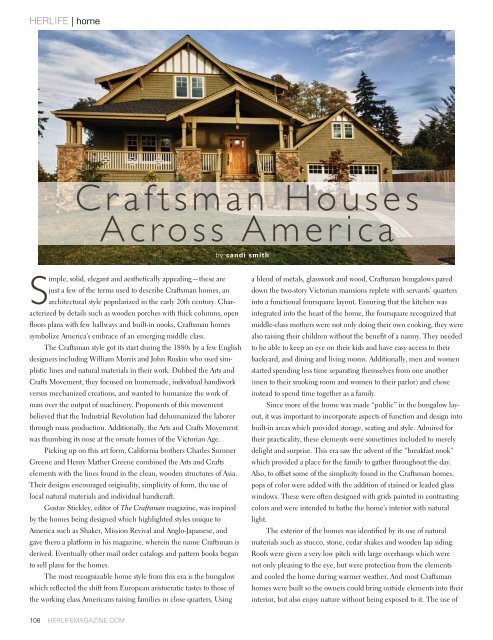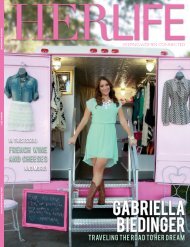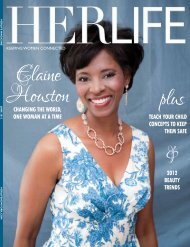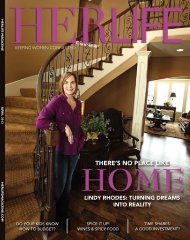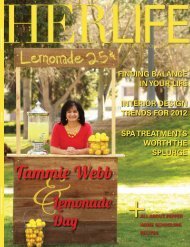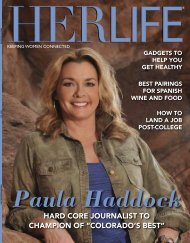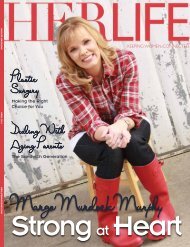You also want an ePaper? Increase the reach of your titles
YUMPU automatically turns print PDFs into web optimized ePapers that Google loves.
herlife | homeCr aftsman HousesAcross Amer icaby candi smithSimple, solid, elegant and aesthetically appealing—these arejust a few of the terms used to describe Craftsman homes, anarchitectural style popularized in the early 20th century. Characterizedby details such as wooden porches with thick columns, openfloors plans with few hallways and built-in nooks, Craftsman homessymbolize America’s embrace of an emerging middle class.The Craftsman style got its start during the 1880s by a few Englishdesigners including William Morris and John Ruskin who used simplisticlines and natural materials in their work. Dubbed the Arts andCrafts Movement, they focused on homemade, individual handiworkversus mechanized creations, and wanted to humanize the work ofman over the output of machinery. Proponents of this movementbelieved that the Industrial Revolution had dehumanized the laborerthrough mass production. Additionally, the Arts and Crafts Movementwas thumbing its nose at the ornate homes of the Victorian Age.Picking up on this art form, California brothers Charles SumnerGreene and Henry Mather Greene combined the Arts and Craftselements with the lines found in the clean, wooden structures of Asia.Their designs encouraged originality, simplicity of form, the use oflocal natural materials and individual handicraft.Gustav Stickley, editor of The Craftsman magazine, was inspiredby the homes being designed which highlighted styles unique toAmerica such as Shaker, Mission Revival and Anglo-Japanese, andgave them a platform in his magazine, wherein the name Craftsman isderived. Eventually other mail order catalogs and pattern books beganto sell plans for the homes.The most recognizable home style from this era is the bungalowwhich reflected the shift from European aristocratic tastes to those ofthe working class Americans raising families in close quarters. Usinga blend of metals, glasswork and wood, Craftsman bungalows pareddown the two-story Victorian mansions replete with servants’ quartersinto a functional foursquare layout. Ensuring that the kitchen wasintegrated into the heart of the home, the foursquare recognized thatmiddle-class mothers were not only doing their own cooking, they werealso raising their children without the benefit of a nanny. They neededto be able to keep an eye on their kids and have easy access to theirbackyard, and dining and living rooms. Additionally, men and womenstarted spending less time separating themselves from one another(men to their smoking room and women to their parlor) and choseinstead to spend time together as a family.Since more of the home was made “public” in the bungalow layout,it was important to incorporate aspects of function and design intobuilt-in areas which provided storage, seating and style. Admired fortheir practicality, these elements were sometimes included to merelydelight and surprise. This era saw the advent of the “breakfast nook”which provided a place for the family to gather throughout the day.Also, to offset some of the simplicity found in the Craftsman homes,pops of color were added with the addition of stained or leaded glasswindows. These were often designed with grids painted in contrastingcolors and were intended to bathe the home’s interior with naturallight.The exterior of the homes was identified by its use of naturalmaterials such as stucco, stone, cedar shakes and wooden lap siding.Roofs were given a very low pitch with large overhangs which werenot only pleasing to the eye, but were protection from the elementsand cooled the home during warmer weather. And most Craftsmanhomes were built so the owners could bring outside elements into theirinterior, but also enjoy nature without being exposed to it. The use of108 <strong>HERLIFE</strong>MAGAZINE.COM


